So, let’s say we want to play nice with the rest of nature. Let’s say we want public parks, yards and gardens which exist for more than show, spaces which support a diversity of life, steward our resources wisely and are a joy to the eye. We’ve got to change the existing lifeless paradigm of lawn and hedge and disposable annual flowers.
How do we do that? What does that look like?
Well, the how part is going to take a few posts to explain–but we can start with what it might look like.
The fantastic thing about this new landscaping paradigm is that it is entirely local. If we remove the heinous, homogeneous, ubiquitous lawn from our tool box, suddenly a yard in Santa Fe looks quite different than a yard in Michigan or a yard in Florida. We return, after a long period of delusion, to the realm of common sense.
Because the new landscapes are entirely local, I can’t even begin to list or imagine all the possibilities, but here are a few of the images I see when I think about a better future:
Get The Latest By Email
First, in terms of public space, I have to bring up Piet Oudolf, though we’ve blogged about him before.
Here’s his work in Chicago’s Millennium Park:
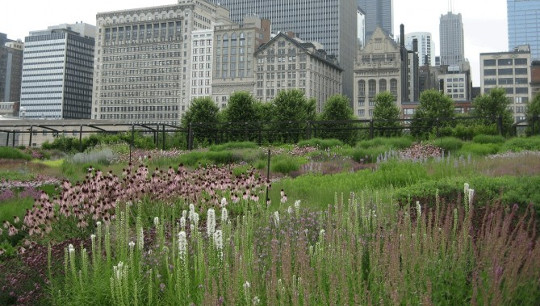 Chicago’s Millennium Park’s Lurie Garden by Piet Oudolf and Kathryn Gustafson”Milpark” by Dan Hiris. Licensed under CC BY 2.5 via Wikimedia Commons
Chicago’s Millennium Park’s Lurie Garden by Piet Oudolf and Kathryn Gustafson”Milpark” by Dan Hiris. Licensed under CC BY 2.5 via Wikimedia Commons
Now, isn’t that better than a vast lawn?
Can’t you just hear the hum of insects and the song of birds?
One thing I really like about Oudolf’s work is that it is designed to evolve with the seasons. Plants are allowed to flower, seed and go dormant, and the dead stalks are appreciated as part of the fall/winter landscape. This is so important, because when we deny the “less attractive” life stages of plants, we also deny our fellow creatures food and habitat in the form of seeds, stems and roots.
And, of course, Oudolf is well known for doing the planting design at the High Line park in New York, a mile and half long section of abandoned elevated train track which first, was transformed by nature into a sort of secret park known only to urban explorers–and then, beginning in 2006, was refashioned into a much loved public attraction by a team of architects and designers.
If you can get your hands on Walking the High Line by Joel Sternfeld, it’s well worth a look to see how nature had gained a strong foothold in on the train tracks before the designers moved in, even though she had to work high in the air on a thin layer of soil. The human designers echoed nature’s original work in the High Line.
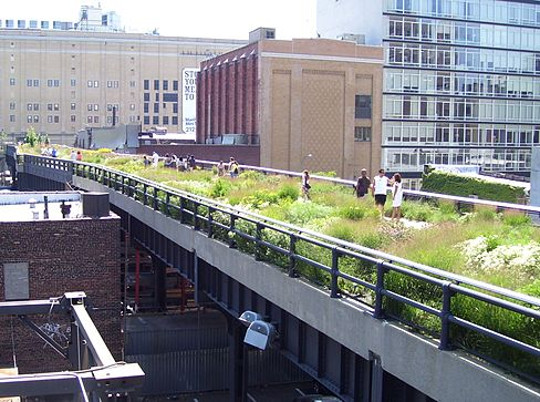 The High Line in Manhattan at West 20th Street by BeyondMyKen courtesy of Wikimedia Commons
The High Line in Manhattan at West 20th Street by BeyondMyKen courtesy of Wikimedia Commons
There are many beautiful photos of the High Line on the Internets, but I can’t put any of them up here without being all creepy and infringy. I highly encourage a quick image search so you can see the garden in all seasons. As a start, check out these images at Gardening Gone Wild.
Okay, so that’s all very well for the professionals and for big parks, but how does this work in smaller spaces?
I think it can work very well. We just have to cast our imaginations back in time before the invention cheap artificial fertilizers and weed killers–not to me the lawn mower–made a carpet of turf the universal default setting in home gardens. What this pre-lawn world looked like, exactly, varied by region.
For temperate climates, one classic mode is the cottage garden, a riot of blooming flowers and herbs:
 Anne Hathaway gardens 2007, by Pessimist – Own work. Licensed under Public Domain via Wikimedia Commons
Anne Hathaway gardens 2007, by Pessimist – Own work. Licensed under Public Domain via Wikimedia Commons
In dryer climes, there’s the Moorish style garden, which also has echoes all over the Mediterranean.
Basically this style of garden emphasizes hardscape for the humans, having plenty of paths and benches and fountains, while the edges of the built areas are planted thickly with climate appropriate plants, often with an emphasis on fruit trees and herbs. Though it is human dominated, it is not hostile to other life–birds have places to roost and bathe, and lizards can sunbathe on the pavement– and it can host a great diversity of plants, which pleases the pollinators.
The photo below is a corner of a larger garden, but could just as easily be the design of a small yard:
 Moorish Garden at Tohono Chul in Tuscon, AZ by DesertCorner. Courtesy of Wikimedia Commons
Moorish Garden at Tohono Chul in Tuscon, AZ by DesertCorner. Courtesy of Wikimedia Commons
Here’s a pic of a beautiful, lawn-free, Southern California landscape which I took on the Theodore Payne Native Plant Tour . If you’re interested in using California natives, check out the tour website. Lots of photos to inspire you!
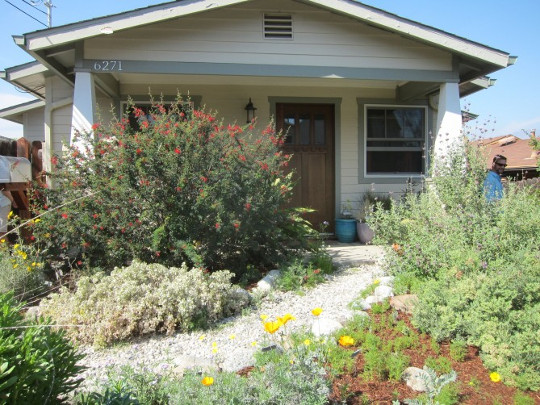 Garden #4 of the 2015 Theodore Payne Native Plant tour, located in Highland Park, CA
Garden #4 of the 2015 Theodore Payne Native Plant tour, located in Highland Park, CA
I really liked this little cottage’s yard because it shows that crafting a loving landscape doesn’t have to be a big, complicated deal. This yard is tiny, but so welcoming to both people and wildlife. (See more details here)
That bush with the red flowers by the porch is called a fairy duster (Calliandra californica), and insects just love, love, love this plant. I wish I had room for one in my yard. (Maybe when one of our fussy fruit trees dies….)
There are also wildflowers, which come and go on their own, and tough-as-nails sages which feed both insects and birds. There’s a little bird bath just out of the frame–water is a gift in this climate. In addition, the gravel walk is permeable as is the mulch in the garden, so the soil can drink in the rainwater. The mulch will also improve the soil, and host invisible life underground.
And that’s our friend David Newsom trying to sneak off the edge of the picture. It’s appropriate that he’s in this post, because he has a great garden himself, and he’s also trying to get the word out about loving the land and the importance of protecting insects such as the honeybee and the monarch.
For the heck of it, here’s another shot of the same yard, just a little more to the right, so you can see the birdbath. I love the mulch. Mulch means good things, like less work and more worms.
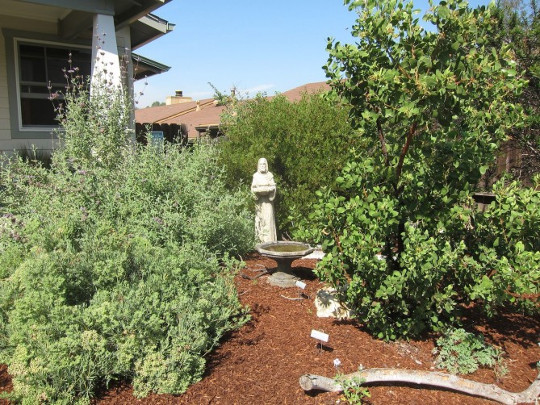 Detail of garden #4 of the 2015 Theodore Payne Native Plant tour, located in Highland Park, CA
Detail of garden #4 of the 2015 Theodore Payne Native Plant tour, located in Highland Park, CA
Another person I think about when I consider a living landscape is Brad Lancaster. If you don’t know him and his work, go and get to know him now.
I saw Brad speak several years ago, and in that talk he described how he had moved into a run-down neighborhood in Tuscon, a place where the landscape was dry and dead, and began to transform his yard and the street area by capturing the rainwater, mulching and planting trees.
Along the way, the neighbors began asking for help with their yards and over time, the whole neighborhood has become a little slice of paradise, a shady oasis full of edible trees like pomegranate and mesquite. He said wild animals, like quail, are even moving back in.
I still remember the pictures from his presentation, but I’m having a hard time finding anything like them to share with you. I’ve shamelessly screen grabbed a still from a nice short video about Brad and rainwater harvesting, called Free Water, by Andrew Brown. I will share this video again later in this series, and we’ll talk more about Brad, too.
In the meanwhile, though the images are not of best quality, look at the lushness of this landscape. This was all done at low cost with basic materials, working smart instead of working hard. This all grew out of nothing. Believe me, there was nothing there but chain link and dust. All of the irrigation comes from rainfall:
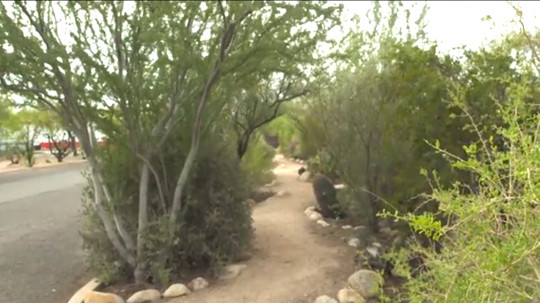
This landscape is irrigated with water from the street flooding which comes with every rain shower.
Note the “curb cut”: the slice of curb removed near the base of the biggest tree. This allows water to flow from the street into a basin around tree.
It seems I’ve been going on for a while now, and I haven’t even scratched the surface of possible landscape modes.
What would a loving landscape look like in the tropics? In the mountains? By the sea? It could also come in the shape of a food forest or a rain garden or even a water garden.
Although the loving landscape doesn’t have to be an exclusively native landscape, a good place to start researching is with your local native plant society or in the native section of your local botanical gardens and local nature preserves. Using resources like this, you can get a feel for the vocabulary of your landscape.
You may also want to research the history of your area. What kind of landscape was there before there were houses? Was it farm? Grazing land? And what was it before it was farm or pasture?
Another good source of information is your local Audubon Society chapter. They’ll be able to tip you off as to ways to help your local birds. The Xerces Society for Invertebrate Conservation (isn’t that a great name?) is another fantastic resource. For instance, they have lists of plants which support native bees, divided by region–not just for the U.S., but for points all over the world. We’ll come back to them, later, too. For now, this is all just grist for the mill.
The thing about the loving landscape is that it does not appear overnight. It takes some contemplation. The lifeless landscape takes no more than ten minutes of thought and a quick jaunt to the nearest big box store to buy lawn seed, a bottle of Miracle Grow and rose bush. A loving landscape is a collaborative process, so you have to start off by learning who your collaborators might be. The birds and bugs and fuzzy critters are the charismatic collaborators, but your real collaborators, your indispensable allies, live beneath the ground, in the soil.
This article originally appeared on Root Simple
About the Authors
 Kelly Coyne and Erik Knutzen, aka Mr. and Mrs. Homegrown, live in the heart of Los Angeles, in a little bungalow set on a 1/12 acre lot where almost all of their land is devoted to growing edible or otherwise useful plants and trees. Their obsessions include bees, bikes, beer, chickens, healthy cities, healing herbs, simple living and good food. In short, everything DIY! Their website is http://www.rootsimple.com
Kelly Coyne and Erik Knutzen, aka Mr. and Mrs. Homegrown, live in the heart of Los Angeles, in a little bungalow set on a 1/12 acre lot where almost all of their land is devoted to growing edible or otherwise useful plants and trees. Their obsessions include bees, bikes, beer, chickens, healthy cities, healing herbs, simple living and good food. In short, everything DIY! Their website is http://www.rootsimple.com
Books by the Authors
 The Urban Homestead (Expanded and Revised Edition): Your Guide to Self-Sufficient Living in the Heart of the City
The Urban Homestead (Expanded and Revised Edition): Your Guide to Self-Sufficient Living in the Heart of the City
by Kelly Coyne and Erik Knutzen.
Click here for more info and/or to order "The Urban Homestead".
 Making It: Radical Home Ec for a Post-Consumer World (2011)
Making It: Radical Home Ec for a Post-Consumer World (2011)
by Kelly Coyne and Erik Knutzen.









